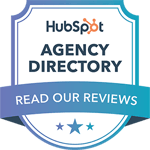
If ranking number one on Google gets you 32.5% of all clicks and ranking second gets you 17.6% of all clicks, then surely ranking one and two should be the holy grail!
Well, the great news is that it is possible, and there are websites that do it even for the most competitive search terms. No matter what niche you’re in, with the right SEO, you can get multiple spots on page 1 of the Google SERP, and with it, give your brand a massive boost in authority.
Understanding SERPs and Their Importance
What Are Search Engine Results Pages (SERPs)?
Search Engine Results Pages (SERPs), or search engine results pages, are the pages displayed by a search engine in response to a user’s search query. When you type search queries into Google, Bing, or any other search engine, the results you see are presented on a SERP.
These pages are a crucial aspect of the online search experience, providing users with a list of relevant websites, images, videos, and other content that match their search query. Essentially, SERPs are the gateway through which users discover and access online content, making them a vital component of search engine optimization (SEO) strategies.
The Significance of Organic Search Results
Organic listings (SERPs) are unpaid listings ranked based on their relevance, authority, and user experience. Unlike paid search results, which are influenced by advertising spend, organic results are determined by the quality and relevance of the content. This makes them a key aspect of search engine optimization (SEO), as they provide a way for websites to increase their online visibility, drive traffic, and attract potential customers.
Organic search results are often considered more trustworthy and credible than paid search results because they are earned through merit rather than purchased. By focusing on high search volume keywords within organic search results, businesses can build long-term authority and trust with their audience.
Why Is It So Important To Rank On P1 Of Search Engine Results Pages?
When you’re ranking at the top of Google’s search engine results pages, it’s like your business has been given the stamp of approval by the world’s knowledge source, and this stamp carries some serious weight.
The fact that you’re one of the top results on Google automatically adds authority to what you’re saying. You must be trustworthy, because how else would you have got to the top of Google?
So, why the obsession with being on P1?
Well, apart from the fact that page one results get the vast majority of traffic, there are other rewards that make ranking on P1 well worth the effort.
When your page features as one of the top listings, you’re reaching a very targeted, engaged audience. These people are actively searching for what you’re offering, and the best part is, there is no advertising involved - you have built an online asset that works for you constantly.
High search volume keywords are particularly valuable as they can drive a significant amount of traffic to your site when you rank on the first page.
No matter what day it is, what time it is, or where the user is, you’re reaching them with the information they’re looking for. This is great for boosting conversion rates in the long-term, and all you have to do to maintain it is keep up with your SEO.
Establishing a strong presence at the top of the rankings brings in free, organic clicks that maintain your brand exposure, create sales, and lower your marketing costs.
How Can You Double Your Presence on the Magical First Page?
The SERPs have changed a great deal over the years, and they’re not just the bare bones links and descriptions they used to be. Modern-day SERPs are much more interactive and visual than they once were, which gives users a better experience but also offers websites lots of different opportunities to feature on P1.
In addition to traditional SEO strategies, focusing on local SEO can help businesses with physical locations achieve multiple listings on the first page.
If you do your SEO well, then these SERP features give you an opportunity to get your brand all over the first page and double down on that stamp of approval you get from Google.
Natural Listings
Although Google is always introducing new SERP features, natural listings still offer a great opportunity to dominate page one.
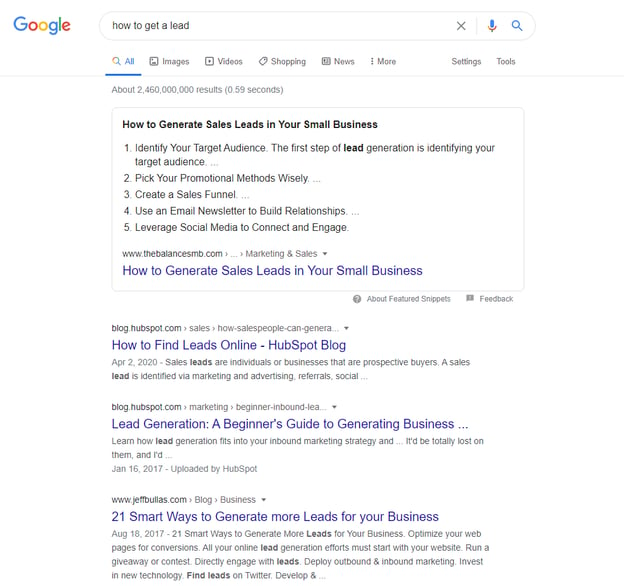
Just look at these results for “how to get a lead.”
The first thing you notice is the featured snippet, which is an immediate eye-catcher and a huge source of authority. The second thing you will notice is that HubSpot owns the first two listings below the featured snippet.
When you see HubSpot in positions one and two (if you count the featured snippet as position zero), you’re going to think “wow, Hubspot must know what they’re talking about.” This is one of the most powerful things about SEO - ranking in the top spots is an automatic validation of your credentials.
How To Rank For Organic Listings Using Search Engine Optimization
- Answer the questions your target audience is asking.
- Create the best content on the web for that subject.
- Build your authority by getting links from other authority sites.
- Always offer value to your visitors.
Social Media and External Websites
Your ability to rank naturally isn’t limited to your own website. Your social media pages and other outside sources such as Medium and Quora also give you a good opportunity to take up multiple spots in the SERPs.
For example, let’s say you wanted to find out “the most important marketing techniques”:
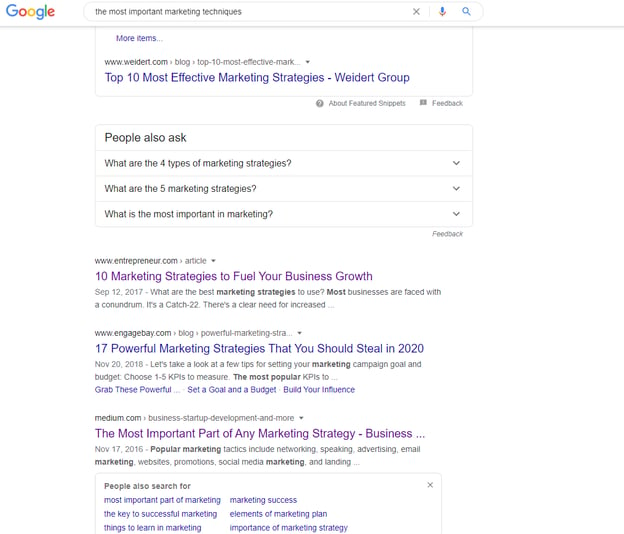
For this query, we see articles from Entrepreneur and Medium popping up in the top five listings. Both of these articles are written by guest writers from a company looking to get brand awareness and increase leads. When you scroll down, you will see the author bio.
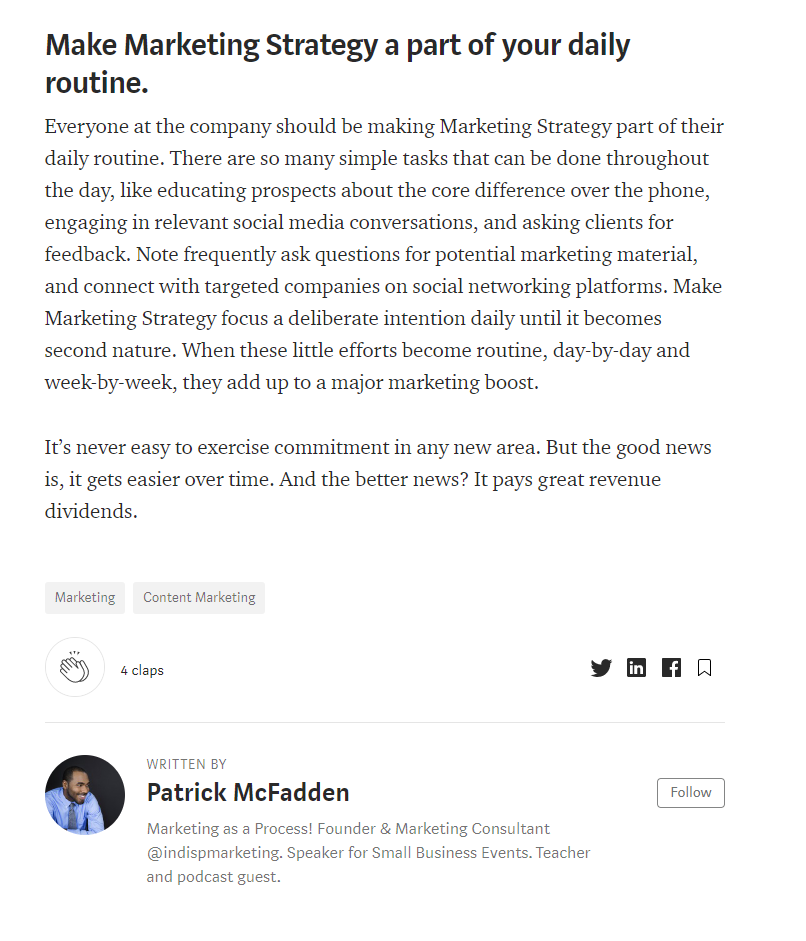
Although this company hasn’t been able to rank directly for the search term “the most important marketing techniques,” they have been able to take advantage of Medium’s domain authority to get their article a prime spot on P1 of the SERPs and boost their brand awareness.
Being featured in Google News can also significantly boost your visibility for time-sensitive queries, as it curates relevant articles in the Top Stories section.
Your social media profiles can also help you take up multiple spots on the first page of the SERPs for your keyword terms and phrases.
Check out this example when searching for “backlinko”. Their social media profiles take up nearly all the spots on the first page apart from their homepage and an article that is all about their company.
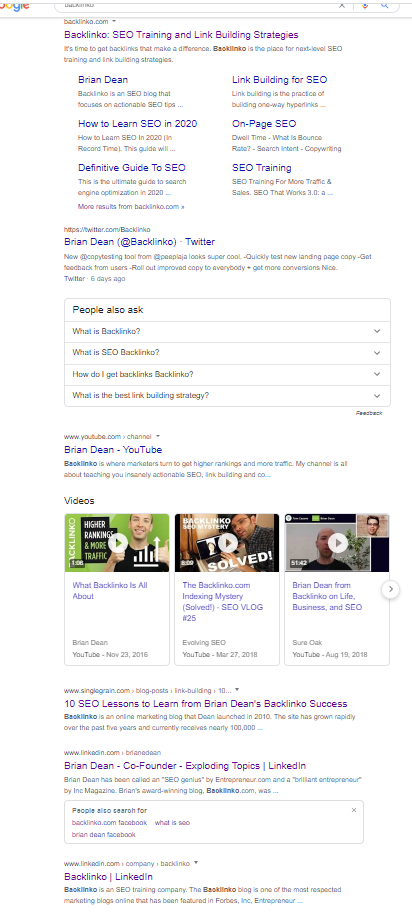
By optimizing your social media profiles, you give yourself a greater chance of ranking on P1 of the search results.
How to Rank Social Media Pages and External Websites
- Treat social platforms as search engines - optimize them like you would your website.
- Leverage external websites to boost your own authority.
- Build links to your pages.
- Target the keywords your audience is searching for.
Video Carousel
Humans love video, and Google recognizes this. As Google’s main job is to give the people what they want, this means that videos feature heavily in SERPs. Throw in the fact that Google owns YouTube, and you’ve got a great opportunity to get yourself another spot on P1 of the results pages.
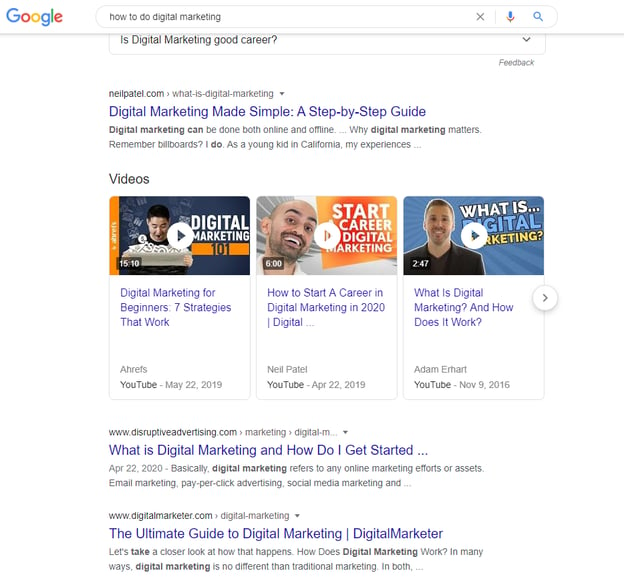
Similarly, Google Images plays a significant role in displaying visual results, making it crucial to optimize your images for search.
On this query for “how to do digital marketing,” you can see the power of the video carousel. It’s huge, and you can’t help but be attracted to it. You’ll also notice that the man who has the top natural listing, Neil Patel, also has a prime place in the middle of the video carousel.
If the top listing wasn’t enough to get your click, then Neil has given himself a second shot at getting your click by finding another spot on P1 of this SERP.
How to Rank for Video Carousel
- Start growing your YouTube account.
- Treat it like your regular SEO, with informative, engaging titles, accurate descriptions, and tags.
- Actively manage video comments.
- Use VideoObject schema markup.
People Also Ask
For a lot of searches, Google is going to present a panel with other questions people ask that are similar to the search query. These boxes have a very prominent position in the SERPs, similar to featured snippets, so if you feature there, you’re going to draw a lot more attention.
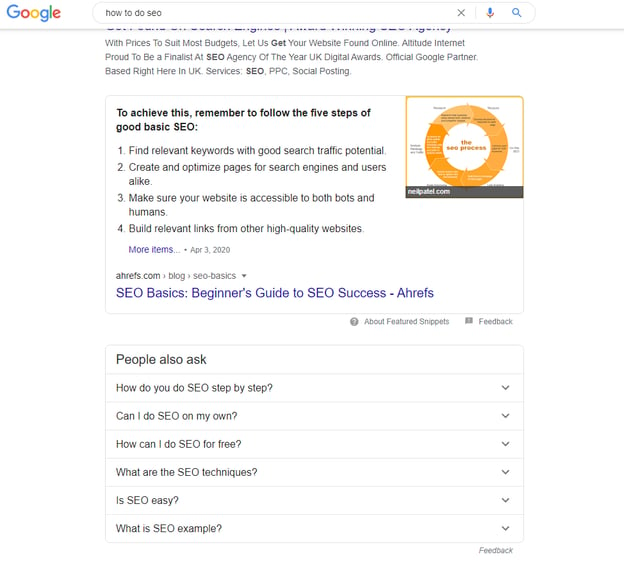
For this query, we can see Ahrefs has the featured snippet, but right underneath it is a huge box suggesting other questions the user might have. If we expand these results, you see another great opportunity to make your mark on the SERPs.
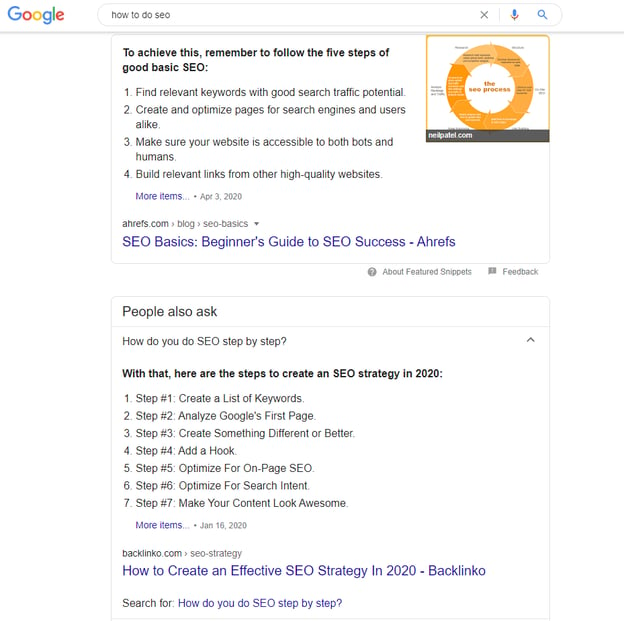
In this case, Backlinko doesn’t rank naturally for the initial search “how to do SEO,” but it still has a major impact on the SERPs just by featuring in the people also ask box.
How To Feature In Related Questions Box And Featured Snippets
- Win the featured snippet for related keywords.
- Focus on the same techniques you use for natural listings.
- Answer your target question in a concise paragraph early in the content (around 52 words is optimal.)
Knowledge Panel
As rich SERP features go, the knowledge panel might just be the most visually imposing.
Take a look at this query for “CRM”.
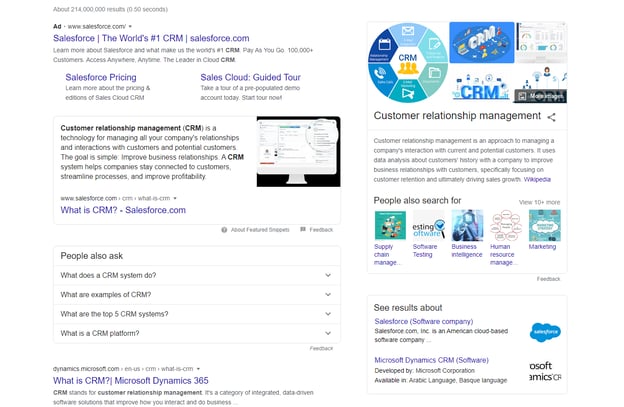
The knowledge panel typically displays to the right of the natural listings and brings together lots of information from different sources.
As you can see, this gives businesses the opportunity to feature prominently in the SERPs multiple times. Salesforce, Microsoft, and Wikipedia occupy the top three organic results, and they also have links in the knowledge panel.
Every little bit of exposure increases your chance of getting a click, and featuring in the knowledge panel is just another way to do this.
SERP Features and Types
SERP features are elements on a Google Search Engine Results Page (SERP) that go beyond the traditional organic results. These features can include knowledge panels, reviews, site links, and more. Understanding these SERP features is crucial for optimizing your search engine rankings and enhancing your online visibility.
Common SERP Features and How to Win Them
-
Knowledge Panels: Knowledge panels provide detailed information about a specific entity, such as a person, place, or organization. To win a knowledge panel, ensure your website is a trusted source of information and has a strong online presence. This can be achieved by consistently publishing high-quality content and earning backlinks from reputable sites.
-
Featured Snippets: Featured snippets offer a brief answer to a search query, often appearing at the top of the SERP. To win a featured snippet, create high-quality, informative content that directly answers common questions related to your industry. Use clear and concise language, and structure your content with headers and bullet points to make it easy for search engines to extract the information.
-
Reviews: Reviews allow users to leave feedback about a business or product, often influencing purchasing decisions. To win reviews, encourage your customers to leave feedback on your website and third-party review sites. Responding to reviews and maintaining a strong online presence can also help improve your visibility in this SERP feature.
-
Site Links: Site links are additional links to other pages on your website that appear below your main listing in the SERP. To win site links, ensure your website has a clear structure with well-linked pages. Use descriptive anchor text and maintain a logical hierarchy to help search engines understand the relationship between your pages.
-
People Also Ask: The “People Also Ask” box provides related questions to the user’s search query, offering additional opportunities for visibility. To feature in this box, create content that answers related questions comprehensively. Use a question-and-answer format and ensure your website has a strong online presence to increase your chances of being featured.
Creating Content for Search Engines
How to Create Content that Can Appear in SERP Features
Creating content that can appear in SERP features requires a deep understanding of user intent, search queries, and the types of content that are most likely to be featured. Here are some tips for creating content that can appear in SERP features:
-
Identify relevant keywords and phrases: Use tools like Google Keyword Planner, Ahrefs, or SEMrush to identify relevant keywords and phrases that are likely to trigger SERP features. Understanding what your audience is searching for is the first step in creating content that meets their needs.
-
Create high-quality, informative content: Develop content that is informative, engaging, and provides value to users. This can include blog posts, articles, videos, and infographics. High-quality content is more likely to be featured in SERP features like featured snippets and knowledge panels.
-
Use header tags and formatting: Use header tags (H1, H2, H3, etc.) to structure your content and make it easier for users and search engines to understand. Proper formatting helps search engines crawl your content more effectively and can improve your chances of appearing in SERP features.
-
Use natural and concise language: Use natural language and concise language to make your content easy to read and understand. Clear and straightforward content is more likely to be featured in snippets and other SERP features.
-
Use schema markup to highlight key information: Use schema markup to highlight key information such as reviews, ratings, and business hours. Schema markup helps search engines understand the context of your content and can improve your chances of appearing in rich snippets.
-
Optimize for featured snippets: Optimize your content to appear in featured snippets by using concise and informative language, and by providing a clear answer to a user’s search query. Featured snippets are often pulled from content that directly answers a question in a succinct manner.
-
Use high-quality images and videos: Use high-quality images and videos to make your content more engaging and to increase the chances of appearing in image and video SERP features. Visual content is highly engaging and can help you capture more spots on the first page of the search results.
Takeaways
Google is always making changes to the way it presents its results, and if you’re nailing your SEO, then this gives you even more opportunities to dominate page #1. Every SERP feature is an opportunity to get a spot on P1 of the SERPs, so make sure you’re paying attention to them.
In our examples, we’re looking at some of the most competitive keywords out there and look at the authority that featuring multiple times on P1 gives those businesses that are successful with their SEO.
When you follow the right SEO processes for your keywords, then you have the opportunity to give your business the same “Google stamp of approval” that our example websites have received. Not all keywords are as competitive as “CRM,” or “how to do SEO,” so whatever business you’re in, you have the ability to find the right search queries and get your pages taking up multiple spots on P1 of the SERPs.
There are lots of opportunities to boost your brand’s authority and get engaged clicks, so aim to take as many spots on P1 as possible.
Contact us at KeyScouts for more information on how to rank on page 1 of the SERPS.
Your landing pages are some of the most important pages in your digital marketing armory. They’re the pages that get you leads, and at the end of the day, that’s exactly what your website is there to do.




